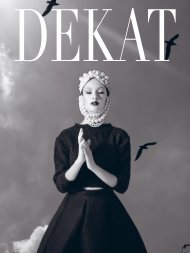DEKAT DIGITAL 2019 - 2020
DEKAT Magazine is the custodian of Afrikaans Culture. Well known for exceptional photography and design, the 2022 luxury edition will delight you. You will find topical lead articles, lifestyle articles focusing on art, culture, design and décor, motoring, food and wine and travel. In addition, we find hidden stories, meet extraordinary people and share divine recipes with you. The 320-page book is a unique window into the lives of the Bohemians and the Eccentrics living on the Southern tip of Africa.
DEKAT Magazine is the custodian of Afrikaans Culture. Well known for exceptional photography and design, the 2022 luxury edition will delight you. You will find topical lead articles, lifestyle articles focusing on art, culture, design and décor, motoring, food and wine and travel. In addition, we find hidden stories, meet extraordinary people and share divine recipes with you.
The 320-page book is a unique window into the lives of the Bohemians and the Eccentrics living on the Southern tip of Africa.
You also want an ePaper? Increase the reach of your titles
YUMPU automatically turns print PDFs into web optimized ePapers that Google loves.
The Neglected Tradition, curated by Steven Sack at the Johannesburg Art Gallery in 1988–<br />
1989, presented the work of many previously unknown or under-appreciated black artists in a<br />
major municipal art gallery for the first time, making the construction of a ‘new’, inclusive history<br />
of South African art possible.<br />
In the aftermath of these exhibitions, the term ‘contemporary’ gained currency, and suddenly<br />
Contemporary African Art, Contemporary Middle Eastern Art, Contemporary Eastern European<br />
Art, Contemporary Latin-American Art and Contemporary Chinese Art became common in the<br />
art world.<br />
Contemporary African Art shares properties with other global contemporary art practices and similarly feeds<br />
into and is shaped by the global art world and its art markets. But in addition, it draws on contemporary local<br />
art practices and reflects particularities specific to African aesthetics and unique to individual African cities and<br />
regions, sometimes drawing almost exclusively on locally known forms of ritual and masquerade. The subject<br />
matter of Contemporary African Art ranges from the quest for an African identity to interrogating colonial<br />
legacies and highlighting current social issues. It negotiates notions of Black Consciousness, Post-Independence,<br />
Post-Coloniality and Post-Ethnicity, and embraces modern cultural pluralism and hybridity.<br />
Theorists argue that Contemporary African Art is neither belated nor peripheral to the global art world, and<br />
does not exist ‘out of time’, but that it has antecedents in modernist African art made during the long quest<br />
for independence from colonial rule after World War II. Contemporary African Art has not emerged out of a<br />
succession of historical movements (such as Realism, Impressionism, Post-Impressionism, Fauvism, Cubism and<br />
Expressionism) because Africa’s history, though intertwined with Europe’s, is different. The stereotypical myths<br />
of the exoticism of ‘darkest Africa’ and its ‘authentic’, if now not so ‘exotic’ past, are therefore thoroughly<br />
debunked. Instead, contemporary African artists interrogate the chasm between notions of a post-colonial<br />
utopia and a post-colonial reality, focusing on the political economy of the continent and the body-politic of a<br />
hybrid culture that celebrates difference and diversity in terms of gender and sexuality among other concerns.<br />
Contemporary African Art now has a unique identity in the global art world, affirmed by an expansive network<br />
of artists, curators, art professionals, researchers and writers, in art industries, art sectors, academia, art<br />
galleries, museums, private art institutions and auction houses, through mega-exhibitions, biennales, art<br />
fairs, art prizes, books, journals, independent research projects, residencies and workshops, and a host of<br />
Contemporary African Art databases.<br />
Biennales, essentially political tools for national promotion, not necessarily social or cultural promotion, are<br />
not new in Africa. The oldest biennale on the continent is the Alexandria Biennale, which started in 1955<br />
and became the Cairo Biennale between 1984 and 2012. Today it is known as Something Else OFF Biennale<br />
Cairo. The best known is arguably the Dak’Art in Senegal, although it is a relative newcomer, having started in<br />
1990. Photography from the continent is featured at the Biennale de Bamako, Mali, which started in 1993, the<br />
PhotoFesto in Maputo, Mozambique, and the LagosPhoto Festival in Nigeria.<br />
In South Africa, the First Johannesburg Biennale in 1995 included art from many African countries, but was<br />
criticised for being too firmly based on the national pavilion approach taken by the Venice Biennale. One has<br />
to keep in mind, however, that South Africa was for all intents and purposes cut off from its African neighbours<br />
during the long apartheid years and the First Johannesburg Biennale was really an attempt to get to know and find<br />
a place in the contemporary art of Africa. Okwui Enwezor curated the Second Johannesburg Biennale in 1997<br />
along the theme of Trade Routes: History and Geography, both very pertinent issues in Contemporary African Art.<br />
47





